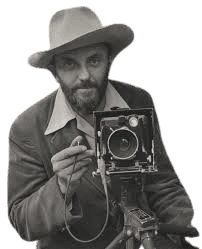Life and achievements
Early life
Ansel Adams was born in San Francisco in 1902 into a wealthy family, but the family lost its wealth in the financial panic of 1907. Adams was shy, hyperactive, and had learning difficulties as a child, leading his father to homeschool him. This provided Adams the freedom to explore the Golden Gate area, where he developed an early connection with nature. His father, Charles Adams, introduced him to the works of Ralph Waldo Emerson, instilling in him a deep appreciation for the natural world.
Adams' second passion was music, and he began playing piano at the age of 12, teaching himself. Music brought structure to his life, and for many years, he aspired to become a concert pianist. However, his life changed in 1916 when he received his first camera—a Kodak Brownie—during a family vacation to Yosemite. This trip sparked his love for photography and marked the beginning of his photographic journey.
In 1919, Adams joined the Sierra Club, meeting conservationists and environmental leaders. His association with the Sierra Club strengthened his commitment to both nature and photography. He was eventually appointed as the club's official photographer, and his early works in Yosemite and the High Sierra established his reputation.
Legacy
Ansel Adams' contributions to the world are seen in both photography and environmental conservation. He is recognized as one of the most famous landscape photographers of the 20th century, particularly for his depictions of the American West. Adams played a key role in legitimizing photography as an art form through his exhibitions at the Museum of Modern Art and his involvement in establishing the museum's photography department.
His Zone System provided a breakthrough for photographers, offering precise control over light and exposure. His attention to detail, both in capturing images and in developing them, set new standards for photographic excellence, with his prints renowned for their tonal range and sharpness.
Beyond his artistry, Adams was a passionate environmentalist. His photographs became iconic representations of America's national parks and wilderness, helping to protect these landscapes. His collaboration with groups like the Sierra Club played a crucial role in expanding the national park system, and his images were instrumental in the campaign to establish Kings Canyon as a national park.
Adams' influence continues beyond his lifetime, inspiring photographers, conservationists, and lovers of nature. His images of Yosemite, the Grand Tetons, and other landscapes remain definitive representations of America's wilderness, and his legacy as both an artist and environmental advocate is enshrined in American culture.
Milestone moments
Jul 25, 1916
First Visit to Yosemite
Ansel Adams first visited Yosemite National Park with his family in 1916 when he was 14.
This trip is one of the most significant in his life, as it was during this time that he received his first camera, the Kodak Brownie.
The beauty of Yosemite left a lasting impression on Adams, inspiring him to express the grandeur of nature through photography.
This visit marked the beginning of Adams' lifelong association with the park, which would be the focus of much of his future work.
Jul 10, 1927
First Major Photograph: "Monolith, the Face of Half Dome"
Adams created his first fully realized photograph, "Monolith, the Face of Half Dome," in 1927.
The image was a departure from the soft-focus pictorialism popular at the time, employing sharp focus and high contrast.
This photograph represented a turning point in Adams' career, transforming him from a hobbyist into a serious artist.
Mar 20, 1934
Elected to the Sierra Club Board of Directors
In 1934, Adams was elected to the Sierra Club's board of directors, where he served for 37 years.
Through his work with the Sierra Club, Adams became an influential environmental activist, using his photography to advocate for the preservation of wilderness areas.
His photographs were instrumental in creating new national parks, including Kings Canyon.
Aug 25, 1941
Moonrise, Hernandez, New Mexico
Adams' most famous photograph, "Moonrise, Hernandez, New Mexico," was taken in 1941.
The dramatic lighting and composition made it one of the most iconic images in photography history.
Adams continued making prints of "Moonrise" throughout his career, and it remains one of the most celebrated photographs of all time.
